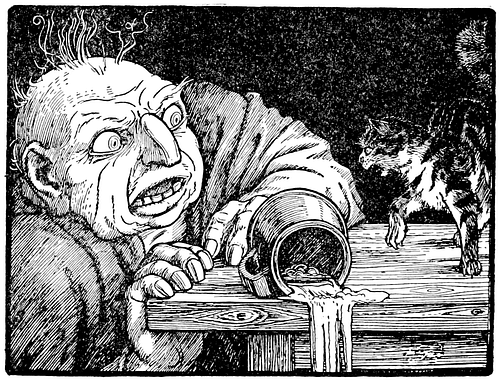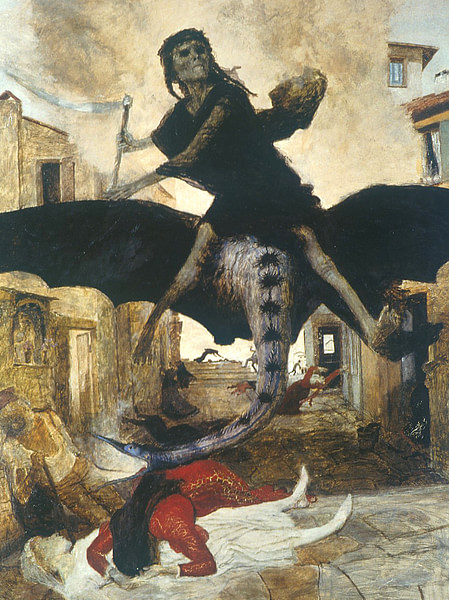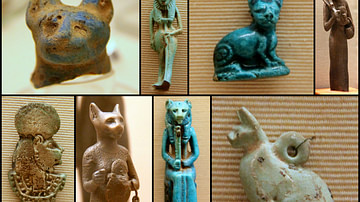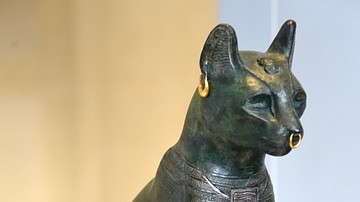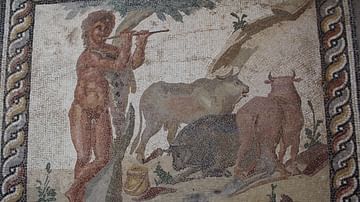Cats in the Middle Ages were generally disapproved of, regarded as, at best, useful pests and, at worst, agents of Satan, owing to the medieval Church and its association of the cat with evil. Prior to the widespread acceptance of Christianity, however, cats were considered valuable members of society and were even worshipped in some cultures.
The life of a cat in the Middle Ages (c. 476-1500) differed significantly from that of a dog owing primarily to its association with witchcraft, darkness, and the devil. In the ancient world, the cat was regarded highly by cultures as diverse as China, Egypt, and Rome but, by the 13th century in Europe, it had long lost its former status and was generally tolerated for its practical use in curbing vermin but not often valued as a pet.
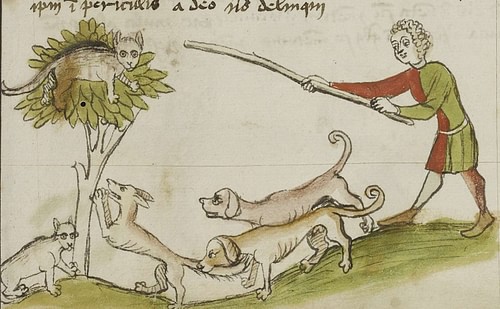
The cat lost its former position through the efforts of the medieval Church which encouraged the association of the cat with devils and darkness as part of their long-standing agenda of demonizing pagan faiths, rituals, and values. Scholar Desmond Morris writes:
Religious bigots have often employed the cunning device of converting other people's heroes into villains to suit their own purposes. In this way, the ancient horned god that protected earlier cultures was first transformed into the evil Devil of Christianity and the revered sacred feline of ancient Egypt became the wicked sorcerer's cat of medieval Europe. Many things considered holy by a previous religious faith have automatically been damned by a new religion. In this way began the darkest chapter in the cat's long association with mankind. For centuries it was persecuted and the cruelties heaped upon it were given the full backing of the Church. (158)
Once the cat was associated with Satan, it was regularly tortured and killed either to ward off bad luck, as a sign of devotion to Christ, or an integral part of rituals involving ailuromancy (using cats to predict the future). Cats were condemned by popes and massacred by entire villages and would not regain even half their former status until the Age of Enlightenment in the 18th century. The Victorian Age of the 19th century would see the cat's full restoration in status.
Cats in the Ancient World
The association of the cat with ancient Egypt is well known. Cats were so highly valued that, according to Herodotus, when an Egyptian house caught fire, the people first concerned themselves with rescuing their cats and only then thought to put the fire out. When a family cat died, the people of the home observed the same grief-rituals as those for a human family member and cats were routinely mummified in the finest linens.
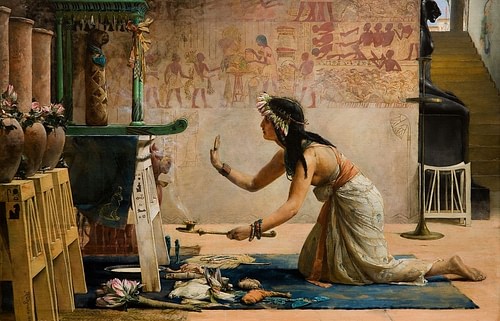
The cat in ancient Egypt was closely linked to the goddess Bastet who presided over the hearth, home, women, and women's secrets. Bastet was one of the most popular deities of Egypt because she promised peace and prosperity to her adherents of both sexes. Every man had a mother or sister, a wife or daughter they cared for and wanted kept safe while also desiring a tranquil and prosperous home and this was what Bastet delivered.
Every year, Egyptians by the thousands traveled to her sacred city of Bubastis for her festival and she and her cats were valued so highly that, in 525 BCE, the Egyptian army at Pelusium surrendered to the Persians who had painted Bastet's image on their shields and herded cats and other animals in front of them before the city's walls. The Egyptians considered surrender preferable to harming the cats.
In Greece and Rome, the cat never attained the same divine status but was still valued. The Greeks recognized the cat's value in pest control and also kept it as a pet while the Romans, who preferred using weasels to rid themselves of mice and rats, concentrated their efforts on pampering their feline friends. Cats enjoyed life in ancient Rome almost as much as they did in Egypt as Latin authors and Roman graves depicting grief-stricken cat owners attest.
The Egyptians forbade the export of cats – the penalty for taking a cat out of the country was death – and instituted a task force at their ports which searched disembarking ships to make sure no cat had been smuggled aboard. Clever crews and captains must have found some way around this law, however, as the cat wound up transported from Egypt to Greece, Rome, and Northern Europe. The sailors most likely responsible for this were the Phoenicians, the master sea-farers and most important traders of the ancient world, who quite possibly also spread the association of the cat with witchcraft and the underworld.
Cats, Women, & Jews
The Phoenicians, traveling from country to country, transported a culture's myths and legends along with their goods. The Greek goddess Hecate (and her Roman counterpart Trivia), presided over death, darkness, magic/witchcraft, and ghosts. Hecate was closely associated with dogs who, legend said, could hear her approach and would howl; a dog which appeared to be barking at nothing was said to actually be warning a family of Hecate and her ghosts at the door.
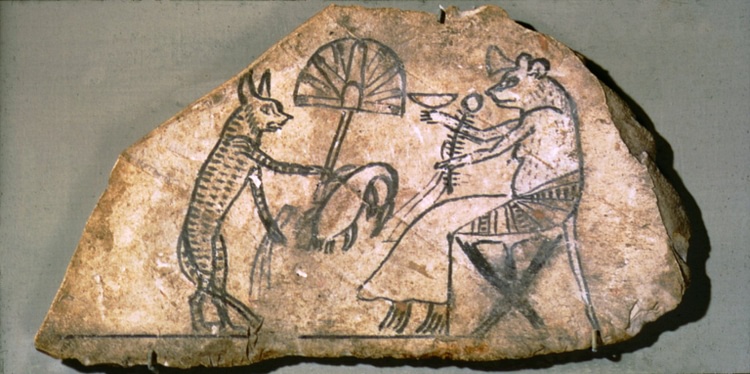
One very popular myth, however, linked Hecate with cats and this was the tale of the great Greek hero Heracles (the Roman Hercules). Heracles is conceived when the god Zeus seduces the mortal princess Alcmene. Hera, Zeus' jealous wife, attempts to kill Alcmene but a woman named Galinthius, maid-servant to Alcmene, thwarts Hera's plan and saves her mistress and the future hero. Enraged, Hera punishes Galinthius by transforming her into a cat and sending her to the underworld to serve Hecate.
The Heracles myth was among the most popular in ancient times and was given a greater boost by the Latin writer Antoninus Liberalis (2nd century CE) in his Metamorphosis, a retelling of older legends and tales, which was copied and distributed from its first publication up through the 9th century and continued as a best-seller through the 16th century.
Even though the majority of the population of medieval Europe were illiterate, this would not have mattered since stories were commonly transmitted orally. This story associating the cat with darkness, witchcraft, and the underworld, coupled with the Church's efforts at demonizing the values of earlier faiths, would have gone far to condemning the cat to a sub-par existence.
Further contributing to the cat's poor reputation was its association with the feminine, carried over from Egypt, and the poor light in which women in the early Middle Ages were viewed. Prior to the popularization of The Cult of the Virgin Mary in the High Middle Ages (1000-1300), coupled with the French romantic tradition courtly love which elevated women's status, women were closely associated with Eve and the Fall of Man in the Garden of Eden. Women were considered innately sinful, lusty, and responsible for man's first fall as well as whatever struggles each individual man after Adam had to endure.
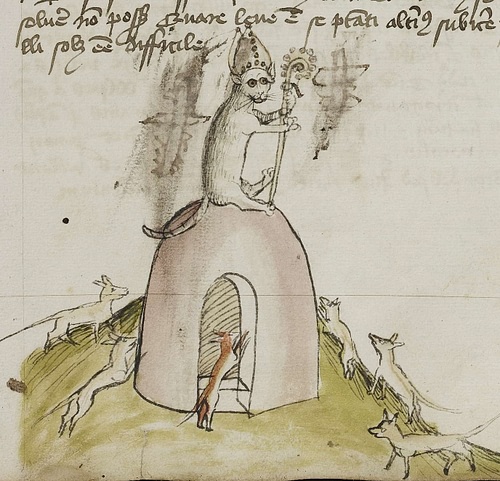
The mythology of the Bible, taken as divine truth, also vilified the Jews as Christ-Killers and during the entire length of the Middle Ages in Europe Jews were linked to the cat as well. Jews were said to worship the cat, were able to transform themselves into cats to sneak into Christian homes to practice mischief or cast spells, and were also believed to crucify cats as a mockery of Christ's death on the cross. To the patriarchal culture of the Middle Ages, then, the cat was easily the vilest creature to creep across the earth.
Cats as Diviners & a Pope's Decree
At the same time, however, medieval Christians found the cat useful for pest control and as a means to supernatural insight. Rats and mice and other vermin, it was observed, were nicely controlled by a cat or two in the house and merchants and ships' crews considered them beneficial as well in protecting grain shipments, or other cargo, in transport or storage.
The practice of ailuromancy, by which one could predict the future by observing a cat's movements, also made the cat a little more appreciated. For the most part, ailuromancy only involved watching a cat whose behavior was thought to be able to predict the weather, an unexpected guest at the door, and other such things. Ailuromancy took a decidedly nasty turn, however, in a ritual known as the taghairm, practiced in Scotland throughout the Middle Ages and up through the 16th century.
A person would take cat and roast it alive over an open flame, turning it on a spit. The cat would scream in agony and this would summon the devil to protect one of his own. The devil would plead with the person to end the cat's suffering but the person would hold out until the devil had promised to fulfil a certain request – often some prediction of the future – at which time the cat would be put out of its misery.
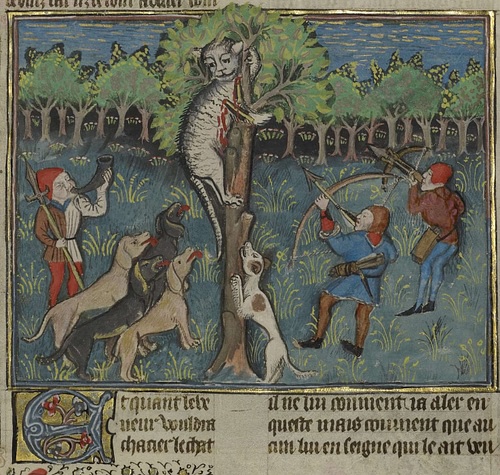
The cat was further linked with the demonic through the work of the writer Walter Map (c. 1140-1210) who claimed that the religious movement of the Patarines (who were seeking reforms in the Catholic Church), whom he closely associated with the heretical sect of the Cathars, worshiped the cat as part of their dark rites. Map reports how, those Christians who had fallen into sin and error in joining the Patarines but who had since returned to the true faith, gave this report of a ritual regularly observed:
At the first watch of the night, with their doors, entrances, and windows closed, the families sit in silence, each in their `synagogue', and wait. And in the middle of them comes, hanging by a rope, a black cat of great size. As soon as they see this cat, the lights are turned out. They do not sing or recite hymns in a distinct way but they mutter them with their teeth closed and they feel in the dark towards where they saw their lord and, when they find it, they kiss it, the more humbly depending on their folly, some on the paws, some under the tail, some on the genitals. (De Nugis Curialum, I.30)
Map's story – corroborated nowhere else and possibly satirical, actually – became so widespread and often repeated that it seems to have factored into the papal bull which condemned cats. Pope Gregory IX (1227-1241), in response to growing reports of heresy throughout Europe, sent the Inquisitor Konrad von Marburg (l. 1180-1233) to Germany to root out heretics by whatever means he felt necessary. Konrad sent the pope back a report of insidious rites enacted which sounds quite similar to Map's earlier account of the cat ritual only with the addition of a frog to the service.
Pope Gregory IX responded by issuing the bull Vox in Rama in 1233 which denounced cats – especially black cats – as evil and in league with Satan. Konrad specifically accused the German noble Henry III, Count of Sayn (d. c. 1246) of participating in these rituals but Henry was able to clear his name before a tribunal and retain his position; Konrad wound up “mysteriously” murdered shortly afterwards. The account Konrad gave Pope Gregory IX could not be corroborated by any other Inquisitor or anyone else at all but the concept of the cat as demonic was further ingrained in public consciousness after 1233.
Again, as with the Galinthius-turned-cat tale cited earlier, it did not matter how many people could have – or even would have – been able to read Gregory's Vox in Rama; what mattered was the Church's stand on cats which would have been absorbed by people through Sunday sermons and simple conversation, filtering down from the higher levels of the Church to the congregations in cities and villages. The bull was hardly widespread to begin with, having only been issued to Henry III, and so its impact could only have been felt indirectly.
However the contents of Pope Gregory IX's bull came to public attention, it was bad news for cats and those who cared for them. Elderly women who kept cats were especially vulnerable to a charge of witchcraft as scholar Virginia C. Holmgren notes:
An old woman living alone with no kin to give aid often cherished a cat as a dear friend and only companion. Cat and crone were always together, the cat making play out of any work, especially the task of trying to sweep the dooryard with a scraggly twig-broom. Any villager hiding in the bushes to spy for proof of witchery might see the cat pounce on the twig bundle for a ride across the bumpy ground, and broom and cat be air-borne for a brief moment of contact with a hidden rock. At that very moment in a nearby castle another beloved cat might be taking the same playful ride on her lady's silken train as she crossed from window to mirror, with those close by smiling fondly. But there were smiles on the faces of those spying villagers as they raced home to report proof of witchcraft in action. (108-109)
Holmgren's observation of the lady and cat in her castle is accurate as evident from the house records of Lady Eleanor of Montfort (also known as Eleanor of England, l. 1215-1275) who kept a cat for pest control but also seems to have cared for it as a pet. Lady Eleanor, powerful enough to control, maintain, and finally negotiate the surrender of Dover Castle, had nothing to fear from accusations of witchcraft but the same could not be said for the women of more modest means in the villages and cities. Of all those accused of witchcraft in Europe in the Middle Ages, 80% were women and the charge almost always ended in the woman's death. Although the most popular image is of an alleged witch burning at the stake, it was far more common to tie the condemned in a sack with her cat and throw both into a river.
The Return of the Cat
The outbreak of the Bubonic Plague in 1348 has often been blamed on a widespread massacre of cats following Pope Gregory IX's Vox in Rama but this theory is untenable as that was only one occurrence of the plague among many; the plague had been killing Europeans long before 1233. Even so, there seems no reason to argue that a decrease in the cat population, before and after the papal bull, would result in an increase in mice and rats and it has been established that there was such a decrease prior to 1348.
Even if that were not so, the incidents of plague from 1233-1348 could be traced to larger numbers of parasite-carrying rodents who were allowed to thrive in the absence of a large cat population. The people of the Middle Ages had no idea that the plague was caused by the bacterium Yersinia pestis (this remained unknown until 1894) and accepted the Church's opinion that it was sent by God as a punishment for sin. Cats continued to be vilified and killed because people continued to view them through the lens of the Church as evil and worthless.
Desmond Morris cites the continued persecution of cats throughout the Middle Ages and into the Renaissance, noting how “as late as 1658 Edward Topsel, in his serious work on natural history, [wrote] `the familiars of Witches do most ordinarily appear in the shape of Cats which is an argument that this beast is dangerous to soul and body” (158). The cat would continue to be seen this way until the Age of Enlightenment in the 18th century.
The Protestant Reformation (1517-1648) broke the power-hold of the Church over people's lives and allowed for greater freedom of thought. Although, as always, there were people like Edward Topsel who clung to earlier beliefs, people were now free to question the Church's views on life in general and cats in particular. The spirit of the Enlightenment encouraged people to keep cats as pets simply for the joy of companionship and this trend would become more commonplace during the Victorian Age (1837-1901) when Queen Victoria returned the cat to the status it had enjoyed in ancient Egypt.
When the Rosetta Stone was deciphered in c. 1822, it opened up Egyptian culture to the world. Previously, hieroglyphics were thought to be some arcane ornamentation but, once it was understood to be a language, Egyptian civilization came into sharper focus and drew worldwide attention. Stories of fantastic finds in ancient tombs made headlines in England and around the world and a number of these referenced Bastet and the Egyptian love of cats. Victoria's interest in Egypt led her to adopt two Blue Persians and she acquired a reputation as a breeder of show cats. As Victoria was a popular monarch, the press reported on her interests, and those interests came to be shared by others who now wanted to have cats of their own.
Victoria's efforts contributed to the cat resuming its ancient place in human society. Her love of cats was noted in America by the popular periodical Godey's Lady's Book, published by Louis A. Godey of Philadelphia between 1830-1878. In 1836, the writer Sarah Josepha Hale joined the Godey's editorial staff and began writing pieces extolling the virtues of the cat and the joys of cat ownership.
The popular author Mark Twain, among many others, added to the momentum writing and lecturing on the sublime joys of the cat-as-companion and so, by the end of the 19th century, the medieval concept of the cat as Satan's instrument had been replaced by that of the feline friend and treasured family member, so familiar to cat lovers in the present day as well as those of the ancient world.
